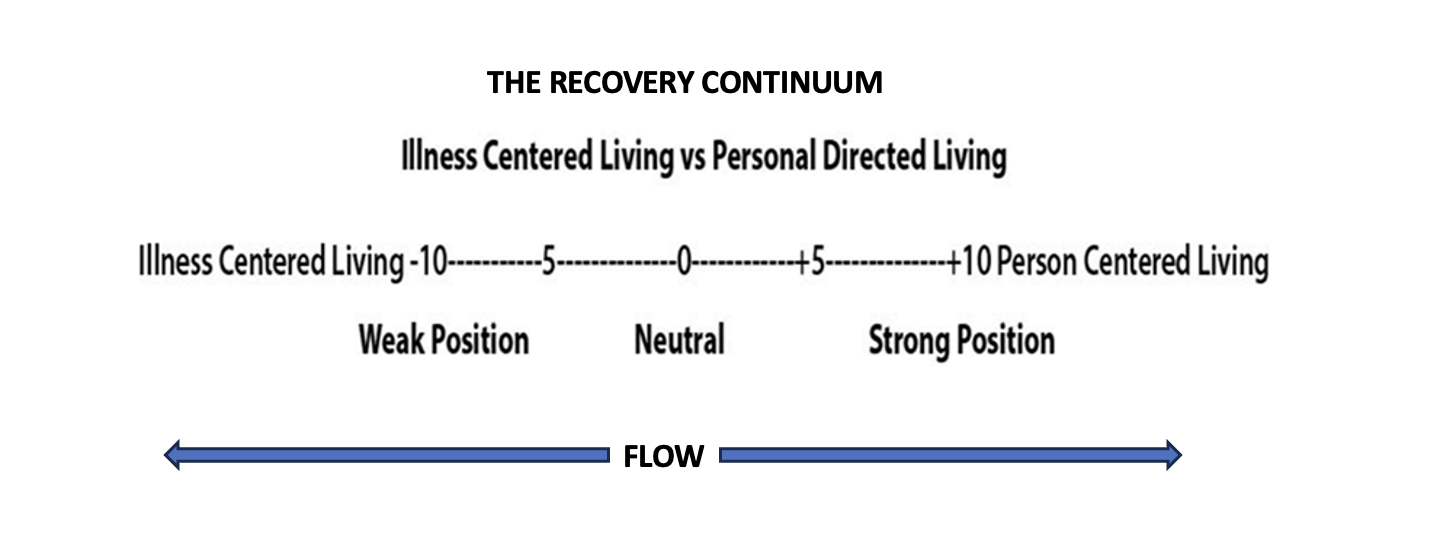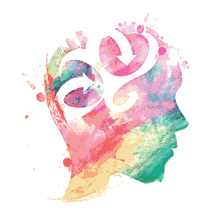
TAKE CHARGE OF YOUR MENTAL HEALTH RECOVERY
THE RECOVERY CONTINUUM
-Living a Recovery Life-
It is recommended that the reader print the “Flash Drive Forms” and “Terms and Definitions” page prior to reviewing this online educational platform to aid one’s comprehension and understanding.
The chart below illuminates the fluid nature of recovery living. Recovering is not a “fixed” and “static” state but rather a continuum that ebbs and flows back and forth naturally. Here, the fluid nature of recovery (see chart below) means people swing between two polarities noted in the diagram, daily, weekly, and monthly, though one may not be aware of it. On one end, this spectrum represents “Illness Centered Living,” and on the other end of the recovery continuum is “Person-Centered Living.” This program aims to minimize the swing between these polarities to the degree that the default position of living for an individual becomes person-centered with minimal swing between the poles.

With “The Illness” (mental health condition) at the helm in “Illness Centered Living”, most decisions and actions a person undertakes flow first through the window of the mental illness to determine the appropriateness of action or non-action. As a rule of thumb, the mental illness condition has no vested interest in a person’s welfare outside of its invested interest in keeping a hold on one’s life. In this recovery position The Illness condition (s) triumphs the person’s best interest. Here, the person is in a weakened stance within their Person-Centered Orbit.
However, with a person being in a strong person-centered position, the decisions and actions flow through filters of values, strength, and capabilities, where the appropriateness of action or non-action is weighed and determined. This occurs despite any resistance put up by The Illness. For example, a friend calls and says, “Hey, let’s meet up this weekend?” an external request. Here, the person knows they value connections and acknowledges this would relieve the isolation and loneliness, though the symptoms are pressing. Despite the pressure, the individual follows through with what is in their best interest. At that moment, the individual exercised a person-centered approach to their life. In another scenario, the person is deciding whether to eat a healthy meal instead of drinking pop and a bag of potato chips, an internally driven request. In a weakened recovery position, The Illness’s filter takes precedence in decision-making in favor of its interests, continuing the suffering and not for the individual’s welfare. At this junction, though the person knows what is right for their well-being, a person-centered position, The Illness condition, would pull more weight in its favor to drink the pop and eat the chips. Here, we find the person’s values and capabilities are not elevated enough in strength to overrule what is not in their best interest.
Based on these scenarios, the recovery continuum flows between “Illness-Led Living” and “Person-Directed Living” moment by moment in decision-making and actions taken or not taken. This recovery program endeavors to strengthen the person-centered position while weakening The Illness-led influence.
With The Recovery Protocol Breakthrough, the object is to spend less time in the “Illness Living Zone” and greater time in the “Person-Centered Zone.” Over time, leading a person-oriented recovery becomes natural to engage with less effort and challenge than before. This, for many people, is a freeing and liberating position compared to being held hostage by mental health conditions due to medication failure.
Background
Over the decades, neuroscience has investigated how our executive (thinking) brain, called the (prefrontal lobe) located under one’s forehead, responds to positive and negative emotions that affect decision-making, social behaviors, and problem-solving. Preliminary findings show that the right hemispheric region of the pre-frontal lobe is activated more with negative emotions, an avoidance-withdrawal approach, than its left cerebral counterpart. This contrasts with the left side of the executive brain, which is activated more with positive emotions and has been associated with approach behaviors and motivation. This heightened left prefrontal lobe activation supports “approach-motivated behaviors,” which move a person toward desirable outcomes in their life. In the Recovery Protocol Breakthrough, the cultivation of this “approach motivation” tied to the left prefrontal lobe is of focus when positive attributes leading to positive emotions are examined. This program focuses on building and sustaining “hopefulness” and “agency,” the core factors in making recovery possible that are tied to the person’s positive attributes. The following exert below further explains the significance of positive and negative emotions on the executive brain,
Braz J Psychiatry. 2017; 39(2): 172–179. Published online 2016 Nov 24. doi 10.1590/1516-4446-2016-1988; A systematic review of the neural correlates of positive emotions published through ncbi.nlm.nih.gov/pmc/articles/PMC7111451/.
Formation and regulation of positive emotions, including happiness, are associated with significant reductions in activity in the right prefrontal cortex and bilaterally in the temporoparietal cortex*(lessoning negative emotional resistance), as well as with increased activity in the left prefrontal regions *(greater positive emotional dominance). Note: This (*) refers to the author’s clarification notes.
While the evidence is preliminary and broad, it provides a useful model suggesting that the induction of positive emotions pulls people toward approach-motivated behaviors that can also inhibit or dampen negative emotions. The program focuses on elevating a person’s strengths and capabilities to induce positive affect, which enhances an individual’s ability to build a person-centered base of empowerment.
Another key focus of the program is based on the theory of the brain’s “Default Mode Networks” (DMN) and autobiographical narratives (stories) tied to negative rumination. With both Anxiety and Depression disorders, there is a tendency to ruminate more at rest with negative self-talk and self-appraisals that place attention on negative autobiographic accounts of a person’s life. These attention biases can lessen the individual’s self-perception of worth and abilities. The opposite is most likely to occur when the DMN rumination is filled with positive self-perceptions and self-talk expressing an individual’s worth and abilities. Such ruminating narratives of this nature, in general, appear more in frequency with people living with these mental health conditions of anxiety and depression than mentally healthy people.
Biol Psychiatry. 2011 Aug 15; 70(4): 327–333. Published online 2011 Apr 3. doi: 10.1016/j.biopsych.2011.02.003,” Default-mode and task-positive network activity in Major Depressive Disorder: Implications for adaptive and maladaptive rumination by, Paul Hamilton, Ph.D., Daniella J. Furman, M.A., Catie Chang, M.S., Moriah E. Thomason, Ph.D., Emily Dennis, B.A., and Ian H. Gotlib, Ph.D.
… we found in MDD (major depression) that greater dominance of DMN — a network that subserves passive, self-relational processes such as recall of autobiographical memories (13) and mind wandering (31) — was associated with higher levels of less effortful, maladaptive, depressive rumination (RRS-D; e.g., “How often do you think about all your shortcomings, failings, faults, mistakes?”).
The approach of the Recovery Protocol Breakthrough is to lessen the self-identification with anxiety and depression-induced stories of failings, faults, and shortcomings, thin appraisals of self, which tend to elicit negative emotions, thus dominating autobiographical stories of personal insecurities. This program aims to lessen illness rumination while increasing positive rumination and strengthening approach-motivated behaviors tied to greater Person-Centered Living.
Reflections
Recovery means re-holding the weight and stress of these mental illness conditions differently and in a manner that is exceptionally more freeing to one’s life than is presently experienced by aligning and exercising one’s strengths, values, and mental health building. This alignment allows one to reorient a life from the weight carried by illness-centered living to a person-centered orientation of strength, a freeing position. This program shows you how -The Fable
“We are all in this together.”
-The Recovery Specialist
